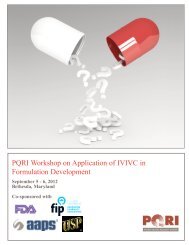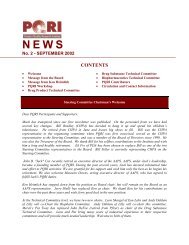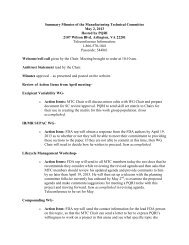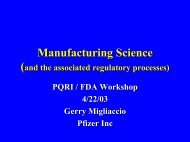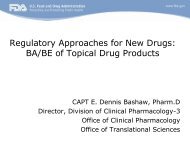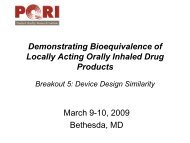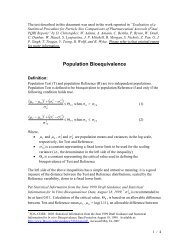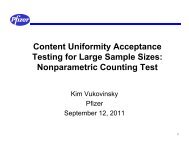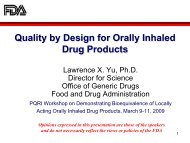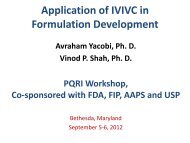Regulatory Perspectives on Extractables and Leachables - PQRI
Regulatory Perspectives on Extractables and Leachables - PQRI
Regulatory Perspectives on Extractables and Leachables - PQRI
Create successful ePaper yourself
Turn your PDF publications into a flip-book with our unique Google optimized e-Paper software.
<str<strong>on</strong>g>Regulatory</str<strong>on</strong>g> <str<strong>on</strong>g>Perspectives</str<strong>on</strong>g> <strong>on</strong><strong>Extractables</strong> <strong>and</strong> <strong>Leachables</strong>Prasad Peri, ONDQA, FDAFeb 22, 2011<strong>PQRI</strong> Workshop <strong>on</strong> Thresholds <strong>and</strong> BestPractices for Parenteral <strong>and</strong> Ophthalmic DrugProducts (PODP)Bethesda, MD.1
Structures of potential leachablesBisphenol A(known teratogen)PVC m<strong>on</strong>omersBenzophen<strong>on</strong>eKnown photo initiator(1-hydroxycyclohexyl)phenyl-Methan<strong>on</strong>, suspected leachable2 2,4,-bis(1,1-dimethylethyl)-phenol (DTBP)Leachable,toxicity to be determinedWould you want these in your drug products?2
• <strong>Extractables</strong>Definiti<strong>on</strong>s– Compounds that can be extracted from thec<strong>on</strong>tainer closure system (CCS) when inthe presence of a solvent• <strong>Leachables</strong>– Compounds that leach into the dosage formfrom the c<strong>on</strong>tainer closure as a result ofdirect c<strong>on</strong>tact with the formulati<strong>on</strong>3
• <strong>Extractables</strong>Definiti<strong>on</strong>s– Compounds that can be extracted from thec<strong>on</strong>tainer closure system (CCS) when inthe presence of a solvent• <strong>Leachables</strong>– Compounds that leach into the dosage formfrom the c<strong>on</strong>tainer closure as a result ofdirect c<strong>on</strong>tact with the formulati<strong>on</strong>4
Outline• <str<strong>on</strong>g>Regulatory</str<strong>on</strong>g> Background/Importance• Recommendati<strong>on</strong>s• Current Status• QbD Approaches to <strong>Extractables</strong> <strong>and</strong><strong>Leachables</strong>• C<strong>on</strong>clusi<strong>on</strong>5
Background• How did the importance ofextractables/leachables come to FDA’s attenti<strong>on</strong>?• In the early 1990s.– Nitrosamines in metered-dosed inhalers elastomers(MDIs)– 2-Mercaptobenzothiazole in elastomers– Other classes of E/L’s– Processing aid residues– Vanillin in inhalati<strong>on</strong> soluti<strong>on</strong>– Aluminum in large volume parenterals6
Why the C<strong>on</strong>cern?• Safety c<strong>on</strong>cerns– MDIs• Sensitive, compromised patient populati<strong>on</strong>s• Paradoxical br<strong>on</strong>chospasm• L<strong>on</strong>g-term safety for chr<strong>on</strong>ic use– Parenterals• Direct exposure to leachables• Quality c<strong>on</strong>cerns– Lack of knowledge/c<strong>on</strong>trol of source materials– Lack of underst<strong>and</strong>ing of potential risks fromextractables <strong>and</strong> leachable– Lack of c<strong>on</strong>trol of extractables <strong>and</strong> leachables7
Relevant Recent Meetings/Courses• PDA <strong>Extractables</strong> <strong>and</strong> <strong>Leachables</strong> Nov 6-8, 2007, Bethesda, MD.• PharmaEd’s <strong>Extractables</strong> <strong>and</strong> <strong>Leachables</strong> 2010, May 2010, SanFrancisco• <strong>Extractables</strong> <strong>and</strong> <strong>Leachables</strong> for Pharmaceuticals Products, 14-15 Sept2010 (L<strong>on</strong>d<strong>on</strong>).• PDA/FDA Joint <str<strong>on</strong>g>Regulatory</str<strong>on</strong>g> C<strong>on</strong>ference, 13-16 Sept 2010, Washingt<strong>on</strong>DC.• <strong>Leachables</strong> <strong>and</strong> <strong>Extractables</strong> Testing <strong>and</strong> Assessment, Nov. 2010,Prague Czech Republic.• IPAC RS Workshop <strong>on</strong> <strong>Extractables</strong> <strong>and</strong> <strong>Leachables</strong> 2011 March.• <strong>Extractables</strong>-<strong>Leachables</strong> Forum 2011, May 17-18, 2011 in Goettingen,Germany8
Potential for <strong>Extractables</strong> <strong>and</strong> <strong>Leachables</strong>Cindy Zweiben, Characterizati<strong>on</strong> of <strong>Extractables</strong> <strong>and</strong> <strong>Leachables</strong> in Parenteral Drug Products, Sept 2010 9
Present <strong>and</strong> Future• Only in the past 15 years have attempts beenmade to proactively design materials fit for usebased <strong>on</strong> increased knowledge about c<strong>on</strong>tainerclosure system (CCS) materials <strong>and</strong>manufacturing processes.• There is room for a risk-based approach forophthalmic <strong>and</strong> some parenteral drug productsregarding E/L studies• Likelihood of CCS – formulati<strong>on</strong> interacti<strong>on</strong>• Potential risk to the patient based <strong>on</strong> theroute of administrati<strong>on</strong>.• If risks not known, can use c<strong>on</strong>servativeapproaches (e.g., MDI/DPI)10
<strong>Extractables</strong> Studies – Why?• For qualificati<strong>on</strong> of CCS comp<strong>on</strong>ents• Used to screen for <strong>and</strong> m<strong>on</strong>itor presence oftoxic materials (e.g., nitrosamines etc.)• Used for quality c<strong>on</strong>trol for acceptance ofCCS comp<strong>on</strong>ents• <strong>Extractables</strong> limits ensure limitati<strong>on</strong>s <strong>on</strong>leachables when extractables arecorrelated to leachables.11
<strong>Extractables</strong> Studies–How?• Use knowledge of comp<strong>on</strong>ent compositi<strong>on</strong> as aninitial guide to developing the extracti<strong>on</strong> techniques<strong>and</strong> analytical methods• Use solvents of varying polarity, multiple extracti<strong>on</strong>techniques <strong>and</strong> analytical techniques• Estimate daily exposure, <strong>and</strong> safety c<strong>on</strong>cernthreshold• Involve toxicologists in assessment12
<strong>Extractables</strong> Studies–How?• Extracti<strong>on</strong>• Water• Polarsolvents• OrganicSolvents13
QbDA systematic approach, predefinedobjectives, product <strong>and</strong> processunderst<strong>and</strong>ing <strong>and</strong> process c<strong>on</strong>trol,science, quality risk management.QbD ApproachProactiveApproachReactiveApproachQuality RiskManagementProcessUnderst<strong>and</strong>ingPharm. QualitySystemEnhancedAssessment ofProduct Quality.15
ICH Quality RoadmapPharmaceuticalQualityQ8, Q9, <strong>and</strong> Q10work together as afoundati<strong>on</strong> forPharmaceuticalQuality(Q8R) (Q9) (Q10)Pharm.DevelopmentQuality RiskManagementPharm.QualitySystems16
ICH Q8(R2) C<strong>on</strong>cepts• Quality should be built in by design• Enhanced product knowledge <strong>and</strong> processunderst<strong>and</strong>ing– Facilitates establishment of design space– Provides opportunities for flexible regulatoryapproaches• Risk-based regulatory decisi<strong>on</strong>s (review &inspecti<strong>on</strong>)17
Role of Quality Risk Management• Role of risk assessment– Early identificati<strong>on</strong> of risk– Risk analysis <strong>and</strong> evaluati<strong>on</strong>– Risk reducti<strong>on</strong> as needed• Risk communicati<strong>on</strong> for c<strong>on</strong>tinuity between– Development <strong>and</strong> manufacturing– Industry <strong>and</strong> regulators– Multiple manufacturing sites• Review of risk can be incorporated– On periodic basis– As part of investigati<strong>on</strong>s of deviati<strong>on</strong>s– As part of change c<strong>on</strong>trol <strong>and</strong> c<strong>on</strong>tinuous improvement18
ProductprofileCQAsRiskassessmentDesignSpaceC<strong>on</strong>trolstrategyLifecyclemanagementQbD Approachto <strong>Extractables</strong> <strong>and</strong> <strong>Leachables</strong>• Desired product profile• Critical quality attribute (CQA)– Minimum level or absence of leachablesFormulati<strong>on</strong> <strong>and</strong> CCS selecti<strong>on</strong> <strong>and</strong> design toc<strong>on</strong>sistently meet CQA• Risk assessment to identify source ofvariability (material, process) <strong>on</strong> CQAs• Design <strong>and</strong> implement a c<strong>on</strong>trol strategy• Manage product lifecycle, includingc<strong>on</strong>tinual improvement19
ProductprofileCQAsRiskassessmentDesignSpaceC<strong>on</strong>trolstrategyLifecyclemanagementQbD Approachto <strong>Extractables</strong> <strong>and</strong> <strong>Leachables</strong>• QTPP-Acceptable levels of leachables• C<strong>on</strong>siderati<strong>on</strong>s– Dosage form <strong>and</strong> route of administrati<strong>on</strong>– Patient populati<strong>on</strong>– Chr<strong>on</strong>ic vs. short-term use– Patients daily exposure– Formulati<strong>on</strong> that is stable <strong>and</strong> not reactive– Delivers c<strong>on</strong>sistent product performance– C<strong>on</strong>tainer closure systems with low <strong>and</strong> safelevels of leachables20
“CCS Underst<strong>and</strong>ing”<strong>Extractables</strong><strong>Leachables</strong>• Not all extractables are leachables• Not all leachables are extractable• When possible, develop a correlati<strong>on</strong> between extractables <strong>and</strong> leachables• C<strong>on</strong>trol <strong>and</strong>/or characterize the leachables that are not-correlated.Anth<strong>on</strong>y Grilli, <strong>Leachables</strong> <strong>and</strong> <strong>Extractables</strong> Testing, A Primer <strong>on</strong> Regulati<strong>on</strong>s <strong>and</strong> Methods21
Risk AssessmentProductprofileCQAsRiskassessmentDesignSpaceC<strong>on</strong>trolstrategyLifecyclemanagement• Underst<strong>and</strong> risks of E/L– Dosage form risk• Inhalati<strong>on</strong>, parenteral > ophthalmic >transdermal > oral > topical– Patient populati<strong>on</strong>• For example, highly sensitive or immunecompromised patients– Use prior knowledge for selecting <strong>and</strong>studying CCS• For example, high pH formulati<strong>on</strong>s <strong>and</strong> glass22
Risk Assessment – E/L’sResinsPlasticizers,Additives,Formulati<strong>on</strong>excipientsStability,StorageReleaseAgentssensitivity<strong>Extractables</strong><strong>and</strong> <strong>Leachables</strong>ElastomersMethodsSpecificati<strong>on</strong>s• Underst<strong>and</strong> potential c<strong>on</strong>tributing factors toward E/Ls23
ProductprofileCQAsRiskassessmentDesignspaceC<strong>on</strong>trolstrategyLifecyclemanagementDesigning the Product• Material selecti<strong>on</strong> for CCS comp<strong>on</strong>ents is driven by– Safety assessment of extractables/leachables– Desired performance parameter outcomes– Formulati<strong>on</strong> compatibility c<strong>on</strong>siderati<strong>on</strong>s• Primary vs. sec<strong>on</strong>dary packaging comp<strong>on</strong>ents– Elevated risks for packaging comp<strong>on</strong>ents in c<strong>on</strong>tact withdrug or patient• Work with supplier– Underst<strong>and</strong> CCS manufacturing process <strong>and</strong> compositi<strong>on</strong>,as much as possible, especially for higher risk comp<strong>on</strong>ents• Make safety assessment of materials to guide thechoice of materials <strong>and</strong> to decrease risk later indevelopment24
ProductprofileCQAsRiskassessmentDesignspaceC<strong>on</strong>trolstrategyLifecyclemanagementUnderst<strong>and</strong>ing the Process• Underst<strong>and</strong> sources of variability for eachmaterial, comp<strong>on</strong>ent, <strong>and</strong> processing used inthe CCS• Evaluate the impact of this variability <strong>on</strong> CCSperformance <strong>and</strong> safety as it pertains to drugproduct– Rati<strong>on</strong>al experiments– Determine who (NDA applicant or supplier) will doexperiments• Work with supplier(s) to ensure appropriateraw material quality, in-process/releasec<strong>on</strong>trols for CCS comp<strong>on</strong>ents to maximizechances for successful development25
Design SpaceMaterials - Process - ProductMaterialsProcessDesign SpaceProductWhile it is possible to have aDesign space for CCS, it isnot necessary as part of aQbD approach.26
ProductprofileCQAsRiskassessmentDesignspaceC<strong>on</strong>trolstrategyLifecyclemanagementC<strong>on</strong>trol Strategy• Prior knowledge useful as a starting point.• The planned set of c<strong>on</strong>trols, derived from currentproduct <strong>and</strong> process underst<strong>and</strong>ing that assuresprocess performance <strong>and</strong> product quality• C<strong>on</strong>trol strategies can include– parameters <strong>and</strong> attributes related to materials <strong>and</strong>comp<strong>on</strong>ents,– facility <strong>and</strong> equipment operating c<strong>on</strong>diti<strong>on</strong>s– In process c<strong>on</strong>trols– finished product specificati<strong>on</strong>s– associated methods <strong>and</strong> frequency ofm<strong>on</strong>itoring/c<strong>on</strong>trol– move the c<strong>on</strong>trol upstream (extractables) to where thesource of variability is likely.– <strong>Leachables</strong> testing when necessary<strong>Extractables</strong><strong>Leachables</strong>27
Setting <strong>Leachables</strong> Specificati<strong>on</strong>Drug substance,formulati<strong>on</strong>, excipientsAnalyticalmethodsStability/storagec<strong>on</strong>diti<strong>on</strong>sCCS materialsselecti<strong>on</strong>Reacti<strong>on</strong> kineticsFabricatorComp<strong>on</strong>ent mfg. process(oils, detergents, soaps,processing aids)Device operati<strong>on</strong>(pressure, temp)<strong>Leachables</strong> dataIdentificati<strong>on</strong>& qualificati<strong>on</strong>Drug productmanufacturing processSpecificati<strong>on</strong>
C<strong>on</strong>trol Strategy – Specificati<strong>on</strong>s• Setting leachables specificati<strong>on</strong> is a circular, labor-intensiveprocess if a proactive approach is not adopted• Specificati<strong>on</strong>s are usually based <strong>on</strong> data; however, amountof research <strong>and</strong> development plays a significant role– Formulati<strong>on</strong>– CCS material– Analytical methods• If extractable studies are performed ahead of time, theburden of setting leachables specificati<strong>on</strong>s becomes easieras– an extractables-leachables correlati<strong>on</strong> can beaccomplished in a single stability study29
Lifecycle ManagementProductprofileCQAsRiskassessmentDesignspaceC<strong>on</strong>trolstrategyLifecyclemanagement• Lifecycle m<strong>on</strong>itoring <strong>and</strong> improvement inCCS material <strong>and</strong> process• Work with suppler related to changes inCCS process– Business decisi<strong>on</strong>s– Alternate sites for better access– Better knowledge of materials• Development of libraries for alternateCCS materials to be interchanged aheadof time since the comp<strong>on</strong>ent marketplaceis c<strong>on</strong>stantly changing30
Summary• <strong>Extractables</strong> <strong>and</strong> leachables (E/L’s) pose a safety<strong>and</strong> quality c<strong>on</strong>cern to certain types of products• The QbD approach can provide a framework for amore scientific, risk-based approach to E/L’s• Risk underst<strong>and</strong>ing <strong>and</strong> management is key• Specificati<strong>on</strong> is <strong>on</strong>ly part of quality c<strong>on</strong>trol strategy• Higher level of underst<strong>and</strong>ing can facilitatec<strong>on</strong>tinual improvement during product lifecycle31
Available References• ICH Q8(R2) Pharmaceutical Development (Aug 2009).• ICH Q9 Quality Risk Management (Nov 2005).• FDA Guidance to Industry, C<strong>on</strong>tainer Closure Systems for PackagingHuman Drugs <strong>and</strong> Biologics (May 1999).• FDA Guidance to Industry (draft), Metered Dose Inhaler (MDI) <strong>and</strong> DryPowder Inhaler (DPI) Drug Products (November 1998).• FDA Guidance for Industry, Nasal Spray <strong>and</strong> Inhalati<strong>on</strong> Soluti<strong>on</strong>,Suspensi<strong>on</strong>, <strong>and</strong> Spray Drug Products (July 2002).• <strong>PQRI</strong> Recommendati<strong>on</strong> (draft), Safety Thresholds <strong>and</strong> Best Practicesfor E/L in Orally Inhaled <strong>and</strong> Nasal Drug Products (September 2006).32
Acknowledgements• Craig Bertha Ph.D.• Alan Schroeder Ph.D.• Christine Moore Ph.D.33




